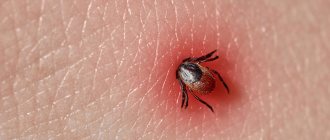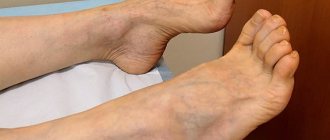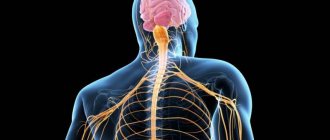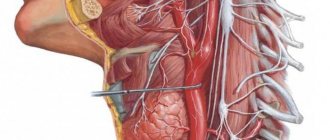NS classification
The nervous system is divided into: central and peripheral.
The central nervous system is the main part, which includes the spinal cord and brain. Both of these organs are reliably protected by the skull and spine. The PNS is the nerves responsible for movement and sensory. It ensures human interaction with the environment. With the help of the PNS, the body receives signals and reacts to them.
There are two types of PNS:
- Somatic - sensory and motor nerve fibers. Responsible for coordination of movement; a person can consciously control his body.
- Autonomic - divided into sympathetic and parasympathetic. The first gives a response to danger and stress. The second is responsible for peace and normalization of the functioning of organs (digestive, urinary).
Despite their differences, both systems are interconnected and cannot work autonomously.
Weak type of nervous system
Fast fatiguability. A person with a weak nervous system is characterized by rapid fatigue, the need for additional breaks for rest, and a sharp decrease in work productivity against the background of distractions and interference.
There is an inability to distribute attention between several things at the same time.
Doesn't cope well with stress . In situations of intense activity, work efficiency decreases, anxiety and uncertainty arise. A weak nervous system is not able to tolerate super-strong stimuli. It either turns off immediately (the inhibitory process prevails over excitation), or it is “carried away” without any brakes, with unpredictable consequences (inhibition does not have time to cope with excitation).
Systematization and control. A weak nervous system is characterized by high resistance to monotony, therefore representatives of the weak type achieve better results in everyday, habitual activities. They work successfully according to the algorithm. There is the ability to plan activities, systematize, and carefully monitor the work done.
Increased sensitivity. A weak nervous system has the ability to respond to ultra-weak signals and distinguish between similar stimuli. It is precisely high sensitivity that determines that some people are able to notice the subtleties of shades, sounds, smells, as well as statements and interpersonal relationships.
by Paul Apal'kin
What are signaling systems
The signaling system is a set of reflexes that connect the body with the environment. They serve as a step in the formation of higher nervous activity.
There are two signaling systems:
- reflexes to specific stimuli - light, sound (available in animals and humans);
- speech system - developed in a person in the process of work.
Personality types according to I.L. Zelenkova and E.V. Belyaeva
Published: 09.29.2018
According to the works of I.L. Zelenkova and E.V. Belyaeva, there is a classification of moral personality types that lifts the curtain on people’s actions and their motivation. In total, the authors describe five personality types. It often happens that one person may have a mixture of several moral personality types with a predominance of certain traits. One way or another, all this is reflected in human manifestations that allow...
no comments yet
Evolution of the central nervous system
The evolution of the functions of CNS cells occurred in several stages:
- improvement of individual cells;
- the formation of new properties that can interact with the environment.
The main stages of phylogenesis that the nervous system went through are:
- The diffuse type is one of the oldest; it is found in organisms such as coelenterates (jellyfish). It is a type of network that consists of clusters of neurons (bipolar and multipolar). Despite its simplicity, the nerve plexuses, in response to irritations, give a reaction throughout the body. The speed at which excitation propagates through the fibers is low.
- In the process of evolution, a stem type emerged - a number of cells gathered into trunks, but diffuse plexuses also remained. It is represented in the group of protostomes (flatworms).
- Further development led to the emergence of the nodal type - some of the cells of the central nervous system are collected in nodes with the ability to transmit excitation from one node to another. The improvement of cells and the development of reception apparatuses occurred in parallel. Nerve impulses arising in any part of the body do not spread throughout the body, but only within the segment. Representatives of this type are invertebrates: mollusks, arthropods, insects.
- Tubular - the highest, characteristic of chordates. Multisynaptic connections appear, which leads to qualitatively new relationships between the organism and the environment. This type includes vertebrates: animals that differ in appearance and have different lifestyles, and humans. They have a nervous system in the form of a tube that ends in the brain.
Personality typology according to V. I. Zatsepin
Published: 09/29/2018
Our former compatriot, now living in Australia, summarizing Western literary data, gives a description of eight basic, from his point of view, personality types: infantile; authoritarian; Machiavellian; accumulative; adventurous; flexible; altruistic; creative (Zatsepin, 2002). Infantile The infantile personality type (psychopath) is characterized by social underdevelopment: dishonesty and lack of empathy. People of this type are quiet, polite, courteous, even charming and at the same time...
no comments yet
Varieties
The scientist Pavlov conducted laboratory research for many years, studying the reflexes of dogs. He concluded that in humans, the type of nervous system mainly depends on innate characteristics. It is the nervous system, its properties, that physiologically affect the formation of temperament.
However, modern scientists argue that this is influenced not only by hereditary factors, but also by the level of upbringing, training and social environment.
Thanks to all the research, the following types of nervous system have been identified, depending on the processes of excitation, inhibition and balance:
- Strong, unbalanced - choleric. In this type, excitation of the nervous system predominates over inhibition. Cholerics are very energetic, but they are emotional, hot-tempered, aggressive, ambitious and lack self-control.
- Strong, balanced, agile - sanguine. People of this type are characterized as lively, active, easily adapt to different living conditions, and have high resistance to life's difficulties. They are leaders and confidently move towards their goals.
- Strong, balanced, inert - phlegmatic. He is the opposite of sanguine. His reaction to everything that happens is calm, he is not prone to violent emotions, and I am sure he has great resistance to problems.
- Weak - melancholic. A melancholic person is not able to resist any stimuli, regardless of whether they are positive or negative. Characteristic signs: lethargy, passivity, cowardice, tearfulness. With a strong irritant, behavioral disturbances may occur. A melancholic person is always in a bad mood.
Interesting: psychopathic disorders are more common in people with a strong unbalanced and weak type of GND.
Types of higher nervous activity
Type classification
. Greek physician Hippocrates, who lived in the 4th century. BC, wrote that each person, based on the characteristics of his behavior, can be attributed to one of four main temperaments: melancholic, choleric, sanguine and phlegmatic. These temperaments correspond well to the four main types of higher nervous activity established by Pavlov on the basis of many years of studying the formation and course of conditioned reflexes in animals. Pavlov based the division into types on three main properties of nervous processes.
The first property is the strength of the processes of excitation and inhibition. It is determined by the maximum strength of stimulation at which conditioned reflexes can be formed. The second property is the ratio of the strength of the processes of excitation and inhibition, in other words, their balance or imbalance. The third property is the mobility of the processes of excitation and inhibition, that is, the speed with which they can replace each other.
Based on the manifestation of these three properties, I. P. Pavlov identified four main types: weak; strong unbalanced; strong balanced mobile; strong, balanced, slow, or calm. This division into types of higher nervous activity also applies to humans, in particular to children.
Weak type
. Children belonging to this type cannot tolerate strong or prolonged irritations, which cause extreme inhibition in them. Induction braking also occurs easily in them. Thus, reflexes are inhibited under the influence of extraneous stimuli, especially new and unusual ones. Such a child, when he first finds himself in a new environment, for example, when visiting kindergarten for the first time, stands with his head down, does not answer questions, holds on to his mother, and can easily cry when asked persistently, repeatedly. Conditioned reflexes are formed slowly, after a large number of combinations with an unconditioned stimulus. Motor activity is small and unstable. The child gives the impression of being cowardly and weak.
The weak type corresponds to the Hippocratic melancholic temperament.
Strong unbalanced type
. This type is also called excitable. It is characterized by a predominance of excitation over inhibition. In children of this type, positive conditioned reflexes are easily formed, and not only to weak, but also to strong stimulation. Inhibition of reflexes, on the contrary, is difficult. Extraneous, even strong stimuli often not only do not cause induction inhibition, but intensify reflex reactions. Negative conditioned reflexes are unstable and often break down. Speech is fast, loud, but uneven. Children are very active and overly excitable. In response to painful stimulation, for example during dental treatment, they can give a general uncontrollable reaction that does not stop for a long time. Even a slight painful irritation can give such a reaction, for example, when applying an iodine solution to a scratch. Due to excessive excitability and weak inhibitory processes, children do not obey discipline well and often (especially when they are hot-tempered) behave defiantly and aggressively. If excessive excitement is prolonged, it may give way to depression, that is, loss of strength, general lethargy.
This type corresponds to the Hippocratic choleric temperament.
There are several options for the unbalanced type:
1. Often very capable, but highly excitable, temperamental children. Very emotional. Their speech and movements are fast. Inhibitory processes, although reduced, are to a weak extent.
2. Hot-tempered, explosive children. Normal behavior is often disrupted, but only for a short time. During the period of explosion they behave passionately and aggressively.
3. Children with a pronounced decrease in inhibition processes. They easily become slaves to their instincts. To satisfy them, they often stop at nothing. Such children are usually called promiscuous and mischievous. Difficult to educate.
Strong, balanced, agile type
. Conditioned reflexes, both positive and negative, are formed quickly. The resulting conditional connections are stable. Extinction, restoration and alteration of conditioned reflexes occur easily and quickly. Frequent and sharp transitions from excitation to inhibition and back do not disrupt cortical activity. Speech is fairly fast, loud, emotional and at the same time smooth, with gestures and expressive, but not excessive, facial expressions. Children are lively, sociable, with bright emotions: they usually show great interest in surrounding phenomena. The analytical and synthetic activity of the cerebral cortex can reach a high level. Such children are easy to educate; often show great abilities.
This type corresponds to the Hippocratic sanguine temperament.
Strong balanced, slow type
. Positive and negative conditioned reflexes are formed more slowly than in children of the previous type. Speech is slow, calm, without pronounced emotions and gestures. The transition from excitation to inhibition and back is slowed down. The child, as a rule, is calm, diligent in his studies, good behavior, and disciplined; easily copes if a difficult situation arises in front of him. Often such children study well and show great abilities. The received task is completed slowly, but conscientiously.
This type corresponds to the Hippocratic phlegmatic temperament.
Plasticity of types of higher nervous activity
. Typological features of higher nervous activity are determined by heredity. However, behavior is determined not only by the innate properties of the nervous system, but also by those of its features that arose under the influence of the environment surrounding the organism from the day of its birth. Consequently, the innate properties of the nervous system cannot be considered as unchangeable. They can change to one degree or another under the influence of upbringing and training. Susceptibility to change, or plasticity, of types of nervous activity is, in essence, only one of the manifestations of the most important general property of the nervous system - its plasticity, adaptability to changing environmental conditions.
The plasticity of types of nervous activity, the possibility of their alteration through exercise and education, are, as Pavlov put it, “the most important pedagogical fact.” Since environmental influences influence the stronger and more lasting the younger the organism, problems of upbringing and education from an early age become of particular importance.
Not all children are equally amenable to education. The most difficult should be considered children with unbalanced higher nervous activity, especially those who were defined above as explosive and dissolute.
If, however, correct educational work is carried out from early childhood, then, as experience shows, it is possible to significantly reduce the bad manifestations of typological characteristics, soften them, instilling in the child strong skills that will prevent the uncontrolled influence of instincts, as well as excessive aggressiveness and irascibility.
How to determine a person's temperament
It is not easy to determine what type of nervous system a person has, since this is influenced by the cerebral cortex, subcortical formations, the level of development of signaling systems and intelligence.
In animals, the type of NS is influenced to a greater extent by the biological environment. For example, puppies from the same litter but raised in different environments may have different temperaments.
Exploring the central nervous system and human psychology, Pavlov developed a questionnaire (test), after passing which, you can determine your belonging to one of the types of GNI, provided that the answers are truthful.
The nervous system controls the activity of all organs. Its type affects a person’s character and behavior. People with a common type are similar in their reactions to certain life situations.
Metabolic disease
A variety of metabolic disorders in the body can cause suffering in the nervous system because... it is very demanding in terms of nutrition and is very sensitive to the toxic effects of products of impaired metabolism. In our clinic, neurologists work in close cooperation with an endocrinologist; if necessary, we will offer you a joint consultation.
Most often we find two variants of metabolic damage to the nervous system:
- Polyneuropathy (polyneuropathy) is the suffering of peripheral nerve fibers (nerves of the limbs, optic and auditory nerves);
- Encephalopathy is a disorder of the brain substance.
A combination of polyneuropathy and encephalopathy is possible.
Treatment at our clinic includes:
- correction of metabolic disorders,
- restorative treatment for the nervous system (detoxification, nootropics, vitamins, magnetic stimulation, gymnastics, etc.).
Treatment of metabolic disorders at the Echinacea clinic
Some diseases that cause metabolic disorders that are detrimental to the nervous system:
- Diabetes mellitus is one of the common causes of polyneuropathy. More details here
- Hypothalamic syndrome is often accompanied by insulin resistance , i.e. cell immunity to the action of the hormone insulin. The nervous system is not able to absorb a sufficient amount of glucose. This is a possible cause of the development of polyneuropathy and encephalopathy. Read more here.
- Hypothyroidism, Thyrotoxicosis and Thyroiditis are diseases of the thyroid gland and a common cause of suffering in the nervous system. Read more here.
- Dysfunction of the parathyroid glands leads to disruption of calcium-phosphorus metabolism and calcium deposition in the subcortical nuclei of the brain. This is a possible cause of muscle cramps, hyperkinesis and secondary parkinsonism. Read more here.
- Liver and kidney failure are possible causes of damage to the brain and peripheral nerves. Characterized by increased levels of urea, creatinine, ALT, AST. GGT in biochemical blood analysis.
- Vitamin deficiency , especially B vitamins, can cause polyneuropathy. A typical case is a deficiency of B vitamins due to regular alcohol consumption.
- Storage diseases lead to the deposition of certain substances (copper, manganese, calcium, etc.) in the tissues of the nervous system and the death of its cells.
Demyelination. Foci of demyelination
Myelin is the sheath of nerve fibers. Demyelination is the destruction of the nerve sheaths, and then the nerve fibers themselves. Demyelination of the brain, spinal cord, and peripheral nerves can occur for a variety of reasons. The most dangerous demyelination is due to the aggression of the immune system against myelin proteins. Treatment of demyelinating diseases in our clinic (DMD) involves searching for and treating the causes of demyelination and stimulating remyelination processes.
Possible causes of demyelination:
- Immune attack on proteins that make up myelin. This occurs due to an error by the immune system, under the influence of infection, or innate characteristics of the immune system. The immune system perceives myelin proteins as foreign and destroys them. This is typical for multiple sclerosis, multiple encephalomyelitis, chronic inflammatory demyelinating polyneuropathy (CIDP), Guillain-Barré syndrome, rheumatic diseases, and chronic infections.
- Metabolic disorders can lead to malnutrition and loss of myelin. This is typical for diabetes mellitus and thyroid diseases.
- Neuroinfection . Myelin can be a target of attack by certain infections, primarily viral ones.
- Paraneoplastic processes are complications of cancer.
- Intoxication with chemicals or aggressive waste products of the body itself (free radicals, peroxides).
Remyelination is the process of repairing myelin sheaths. The remyelination process can be stimulated in different ways - more details on this page











